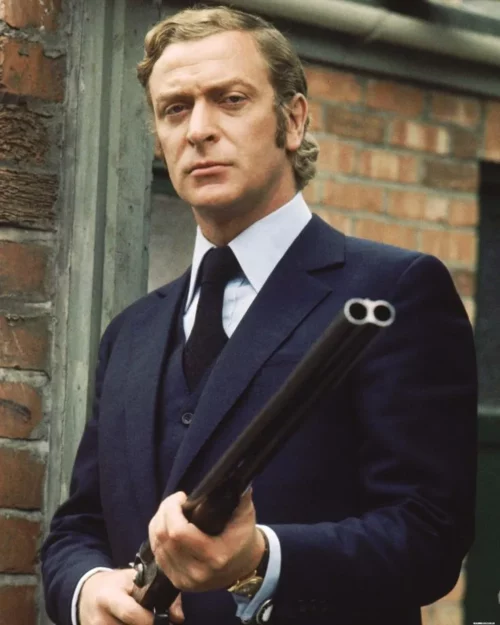There are two main reasons people use mohair for tailoring today. One is for eveningwear, when they want something with a little more sharpness and lustre; the other, less common, is as an alternative to high-twist wools in the summer.
And there’s a third, increasingly rare, which is to be deliberately influenced by Mod style. When mohair/wool suits first became popular in the 1960s they were worn by varieties of younger people, but Mods made them their own.
The look had a revival in the 1980s, and when I was growing up in the 1990s it was brought back again by Ozwald Boateng. I owned a purple Boateng suit at the age of 17, bought attractively cheap in Bicester Village. It was sharp and exciting, but I confess I barely wore it.
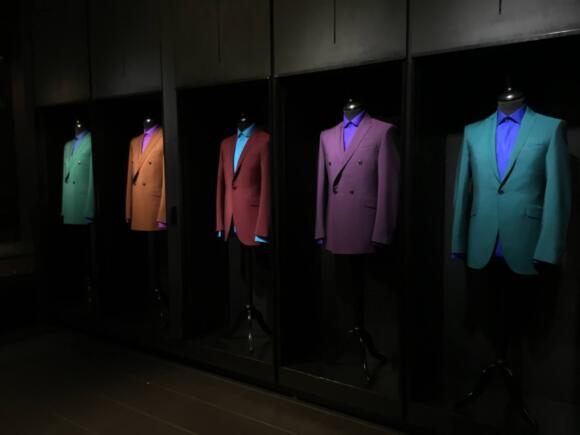
Mohair’s two key properties as regards tailoring are its two-tone sheen and a particular combination of lightness and sharpness. If you were a club-goer in the 1960s, or a jazz musician on stage, the first made it exotic and the second practical.
Made from the hair of the Angora goat (not to be confused with ‘Angora’, the wool from the rabbit of the same name), mohair is a strong for its weight, warm for its weight, crease-resistant and naturally elastic.
It also takes dye well, which is one reason suits were often made in vivid colours. In fact that association is, I think, just as important as the sheen when it comes to why people are put off by mohair. Open the Standeven ‘SummerStrand’ book and your eye is caught by teal, burgundy and peach alongside black and grey. It can be hard to shake that.
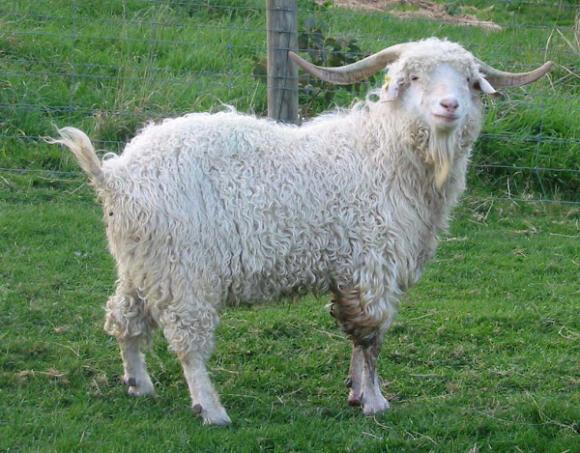
Summer tailoring
Let’s return to the main uses for mohair today, and so why you might consider using it.
First, mohair’s lightness and ability to hold its shape make it an effective alternative to high-twist suitings. John Hitchcock, the ex-head cutter at Anderson & Sheppard, used to wear mohair-mix suits in the summer to great effect.
“They were cut in a classic manner, softly tailored with wider trousers,” one contemporary remembers. “Made like that, a mohair suit was very different to the tighter-fitting Mod suits, or Boateng’s long nineties jackets. It showed me how they could be elegant.”
In some parts of the world, tailors also find they’re popular because high-twist wools like Fresco can be so matte and dry, with a pronounced texture from the thicker yarn. There are less rustic high-twists of course, like Ascot or Crispaire, but there’s also a correlative reduction in sharpness and breathability.
“I find customers in south-east Asia often prefer mohair mixes because they’re sleeker than high-twists,” one English tailor tells me. “They have a little shine and are similar in some ways to the superfine wools they associate with luxury.”
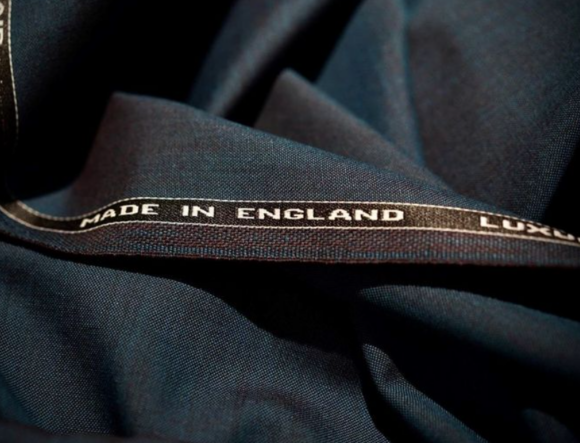
High and low mohair content
This brings us onto the amount of mohair in a fabric, as the proportions make a big difference. A little mohair is usually a performance enhancer; mostly mohair creates a real look.
When mohair was developed as a suiting in England in the 1960s, it was by using it in the weft with wool in the warp. The mohair content was high as result, with William Halstead in England the first to find a way to weave it effectively, without too many of its natural flaws. The most famous brand though became Tonik, sold by Dormeuil, which used a thicker yarn (three-ply twist) and was almost more like a Fresco in texture.
After that, the most popular mix for a long time was 87/13 wool/mohair – Burberry used it famously for many years, and it settled down to become the industry standard. Today the market tends to split in two: mixes around half mohair or more (often referred to as British mohairs) and ones with around 5-15%% (more commercial and more European).
The second type adds a little of mohair’s properties without making it a mohair cloth. It’s basically a worsted wool with slightly more crispness and lightness. The first, on the other hand, is really mohair: this is where you see its naturally uneven texture, quite similar to slubby linen. You also see the two-tone lustre, which becomes apparent as the material moves and folds.
The other major difference between mohairs is weight. Older mohairs were 11-13oz and up; today most are around 8oz, with the greater emphasis on coolness. That, the amount of mohair, and some production techniques that are no long possible (eg flyer-spun) are what make vintage mohair more characterful.
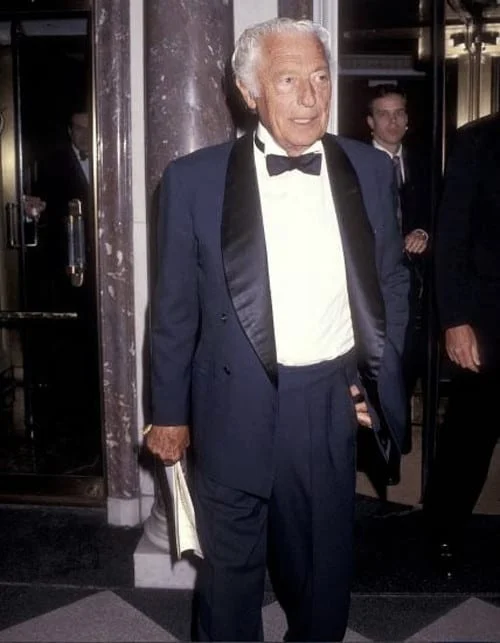
Dinner jackets
It shouldn’t be surprising that mohair became popular for evening wear – the combination of crispness (for a sharp look), lightness (to stay cool indoors) and sheen (for a bit of glamour) were perfect.
Gianni Agnelli is often referenced here, though personally I’m not a big fan of the blue colour, satin lapels or undone style of his dinner jacket (above). Black tie is one of those areas where you really shouldn’t be too sloppy or undone. That waist should be covered if nothing else.
I had a dinner suit made by Richard Anderson in a mohair cloth back in 2014 (below). It was a high mohair content – 40/60 I think – and very sharp. In retrospect though it wasn’t really what I wanted. The sheen was a bit too much and I didn’t like the crispiness. Today I’d use a barathea, as deep and matte as possible.
Structured English tailors used to like mohair because they could get a very sharp waist on a jacket. When your priority is a square shoulder and as slim a waist as possible, mohair’s ability to hold a shape is perfect. It’s my purely personal preference to favour something more soft and draped.
However, one of the reasons I wanted to write this article was that I am having a black mohair suit made with J Mueser – 70/30 wool/mohair, Dugdale’s – that is intended to not be black tie, but rather a sharp, slightly rock ‘n’ roll evening option. Two button, belt loops, very sharp. I’ll cover that later in the year.
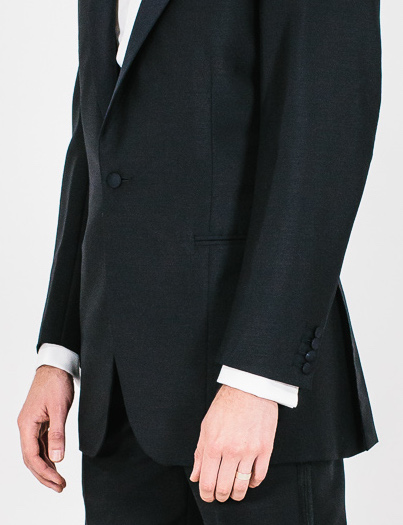
Bunches
These are a few of the main bunches and what they offer. I’ve focused on the ones I know personally, but most of the options should be covered.
Standeven is the merchant arm of William Halstead, probably still the best-known English mill for mohair. They certainly have the biggest range, with five varying bunches. They break down as:
– British Mohair – The higher percentage bunch, as British mohair historically was – a mohair weft with a worsted-wool warp. Plains and other suiting patterns, 8 and 9 ounce. The close-up of cloth higher up is from this bunch.
– Carnival – The other high-percentage bunch, with a particular focus on colour. Fabrics are piece-dyed to get a really vibrant range
– Cape Town – The vintage-feeling bunch, more like Tonik. Basically from being a two or three-ply, giving it a drier feel. Think Michael Caine in Get Carter (below).
– Summer Strand – The lower percentage bunch, along with Festival. Around 6% mohair, with classic suitings alongside lots of colours
Most big mills/merchants have mohair in their collections, if only as part of a ceremonial range. Italians like Loro Piana and Ariston for example. Four others with standalone bunches though are:
Mohair, Dormeuil – This contains just two colours of the original Tonik quality (black and midnight blue) and the rest are a range of mohair/wool mixes, often with a touch of lycra. The bunch ‘Tonik Wool’ is just their high-twist wool range.
Cape Kid, Harrisons – Traditional English mohair in the 40/60 mix, 8oz. A lot of shades of blue, charcoal and black, with patterns such as glen checks and pin stripes for variation, rather than colours.
English Mohair, Holland & Sherry – Lower percentage, with 80% Super 100s wool and 20% mohair. All plains in a variety of colours, rather than adding patterns.
Mohair, Drapers – The main outlet for VBC mohair, in a mohair mix between the previous two at 71/29. All plains, with a big variation in dark colours rather than more vibrant tones.
